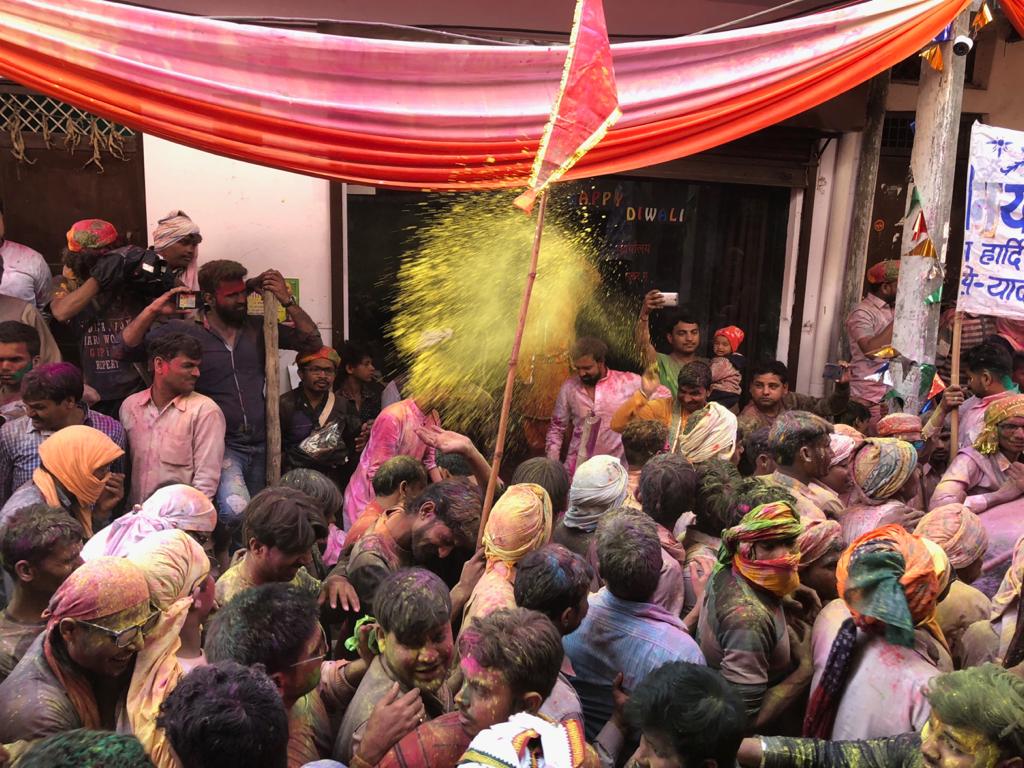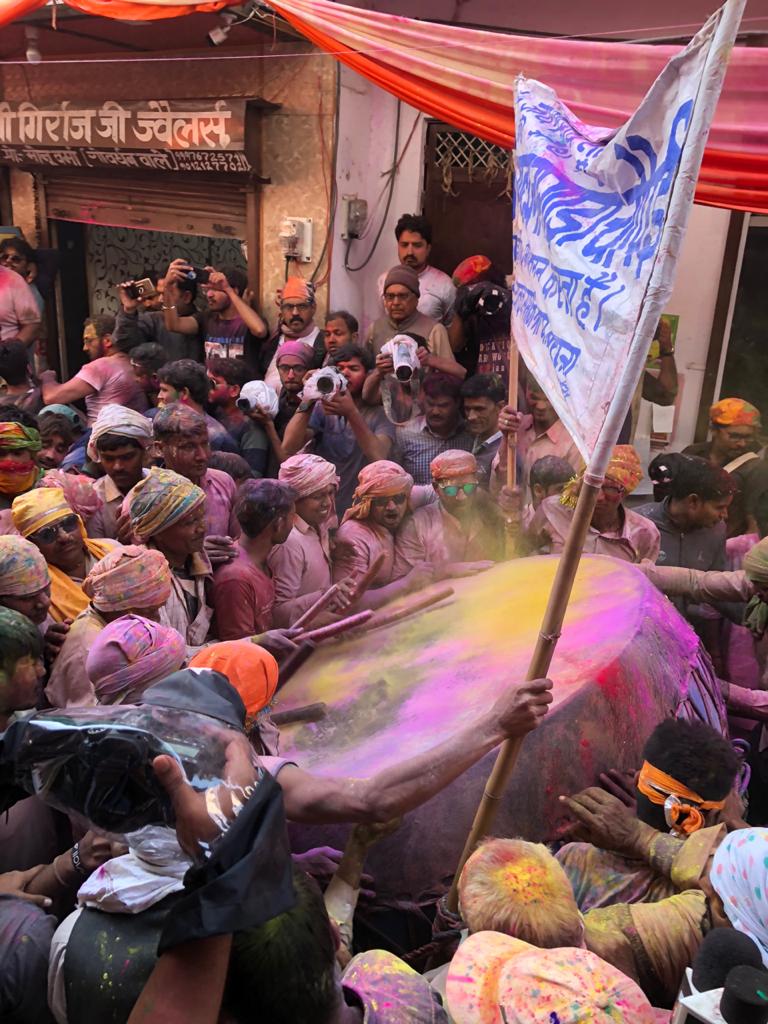A gopal (shepherd) from Nandgaon is sitting on his knees. He is holding a shield over his head to protect himself from gopis (shepherdess). A gopi covering her head with an electric blue ghoonghat (veil) brings down her stave on the shield, with the precision of a guillotine’s snap. Another gopi, standing in close proximity, wearing a bright red sari with zari (gold or silver colour thread work) embroidery is ready to attack. Continuous thuds reverberate throughout the expanse of the street as women from Barsana pummel men from Nandgaon.
This is the performance of the semi-ritual spectacle, Lathmaar. It is an annual celebration leading up to Holi in Barsana, Uttar Pradesh. Taking place in the evening of the ninth day of the Hindu calendar month of Phalguna, a few days before Holi.

Gopis dressed in bright hues of pink and red, surround a gopal as they play Lathmaar together. Photo: Mihika Rungta
Lathmaar is restricted to the members of the Brahmin community living in Nandgaon and Barsana. Nandgaon is believed to be the village where Lord Krishna grew up and Barsana is said to be Radha’s home. Nandgaon and Barsana are two villages in ‘Braj bhoomi’, a region in Uttar Pradesh, around Mathura-Vrindavan.
“Since the time of Radha and Krishna, people from Barsana and Nandgaon don’t marry into families from the other village,” says Narayan Lal, a pundit from Barsana. This unique principle is accepted by the people living there. Vijay Kumar, a Brahmin from Nandgaon says, “There is only one relationship between us and that is a strong bond of friendship.”
This is why men from Nandgaon refer to women from Barsana as bhabhi, and the women, in turn, consider the men as their brothers-in-laws.
Also read: ‘Holi Against Hindutva’: US College Students to Hold Protest Against Delhi Riots
The politics of ‘Radhe Radhe, Shyaam Mila De’
In Braj, Radha is worshipped before Krishna. “Barsana celebrates women, believing they carry the legacy and strength of Radha,” says Harikrishna Lal, the temple pundit (priest) of Sreeji Temple, Barsana. Chants like ‘Radhe radhe shyaam mila de (Radha Radha make us meet Krishna)’ echo around Barsana on this day. Devotees of Lord Krishna are convinced that the road to reach Krishna’s heart is by pleasing Radha.

A man from Bihar has his face covered in ‘Radhe’, written with Sandalwood. Photo: Mihika Rungta
There is a myth around the origin of this festival. Govind Prakash, whose family has been living in Barsana for four generations, says “It is believed that Krishna came to Barsana with his friends to play Holi with Radha and the other gopis. He and the other gopals took the liberty to tease Radha and her friends. Radha and her sakhis (friends) were enraged at Krishna’s audacity and chased them out of Barsana with sticks.” Lathmaar is the recreation of this event from the life of Radha and Krishna.

Men from Nandgaon huddling towards Shreeji temple in Barsana with the flag, representative of Lord Krishna. Photo: Mihika Rungta.
On the day of Lathmaar, the gopals from Nandgaon come to Barsana with a tall bright red flag, symbolic of the arrival of Krishna. They run up the stairs of the Shreeji Temple to go play Holi with Radha. The temple pundit plays Holi with the flag and drenches it in colour completely to symbolise the overpowering of Krishna by Radha. After this, men from Nandgaon parade the streets of Barsana with large drums, calling out to their bhabhis (sisters-in-law) in Barsana to come and play Lathmaar with them.

Brahmins from Nandgaon beating a large drum to call the Gopis in Barsana to come play Lathmaar with them. Photo: Mihika Rungta.
How do the women play?
Inside the home of pundit Narayan Lal, his wife Brijlata is preparing to go play Lathmaar. Holding her long wooden stave, she is ready. “They are prepared as though they were soldiers going for battle,” says 24-year-old Anuradha Lal as her mother picks up her stave. They are fed milk, ghee and almonds to make them stronger for a month in advance.

Brijlata, dressed in a bright pink and mauve sari is laden with jewelry. Photo: Mihika Rungta.
On the streets, gopals from Nandgaon sing and dance with the gopis. “Aaj ke din aise hi chher chaar chalti hai, (On this day, teasing goes on)” says a Rajasthani man with a long moustache, wearing a multi-coloured turban. A gopi with her face covered behind the ghoonghat of her bright pink net sari spins around herself, dancing with a gopal. He sings songs in appreciation of her eyes, her waist and the value her presence adds to the mahaul (atmosphere) of the day. On this day the spotlight is on the women as men take the backseat.
“We dominate for the whole year, even they should get one day,” says Satyaveer Singh, a 43-year-old man from Barsana.
This power dynamic which is so welcome on this day is not otherwise ordinary to the people of Braj. How do women in Barsana feel empowered by this performance that they are allowed to do once a year? After playing Lathmaar, the gopis ritually prepare a meal for their husband and family. “It is to show that I am dedicated to the family and fulfil my responsibilities towards them,” says Brijlata.
The leela of Radha and Krishna, the boundaries of patriarchy and the joyous turmoil merge and submerge in the festive colours.
Mihika Rungta is a student at Ashoka University
All photos provided by the author